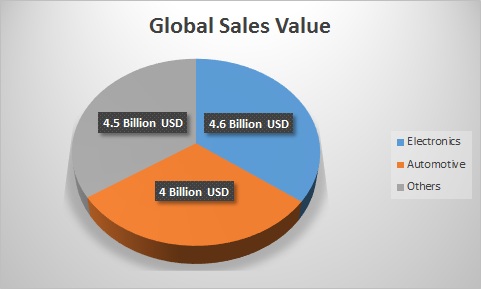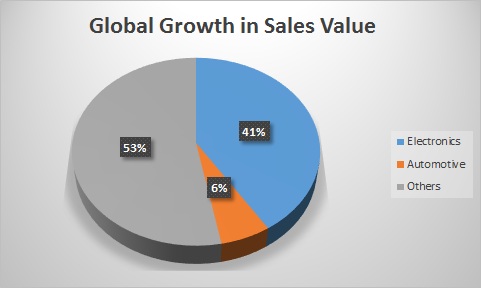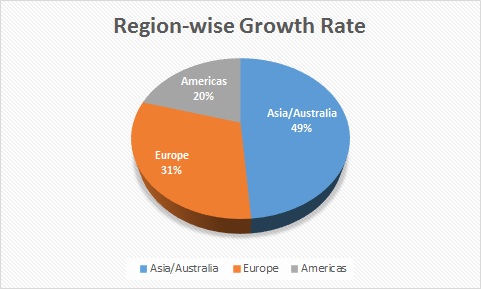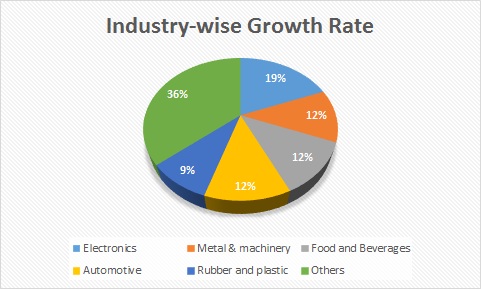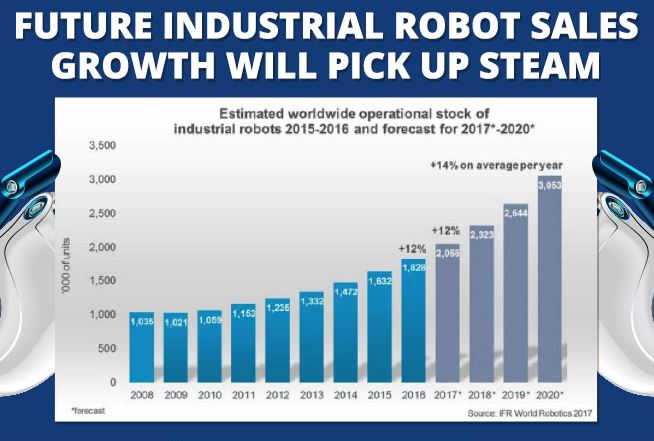Robots are a common sight today in the industry shop floors. An introspection into their entry and rise to prominence in global industries is worthy. Past statistics provide us with a clear insight as to why robots in industry are becoming indispensable
Overview of the International Federation of Robots (IFR) -World Robotics 2017 Report
Global industrial robotic sales value was US$ 13.1 Billion in 2016 (with a 16% growth over 2015)
Global Sales value
Major sector wise:
Global Growth in Sales Value
Major sector wise:
Region wise Growth in Sales Value
Post-recession period 2011-16
Comparison of robot units sold pre-recession v/s post-recession
Pre-recession period 2005-08
Robots sold per year 115,000
Post-recession period 2011-16
Robots sold per year 212,000
“The post-recession period saw a solid growth in robot numbers of 84% over the pre-recession period!”
This provides ample evidence that robots have come to stay in the industry.
Estimated Global growth in sales Value
In 2017-Average growth of 18%
From 2018 to 2020-Growth per year of 15%
Broad perspective on the future of industrial robotics
Key enablers
1. Collaborative robots, IoT and Machine Learning/AI will lead robotics in the coming years.
2. Robots will acquire enhanced skills and be brainy and smarter through the learning processes and adapt them tot heir assigned work.
3. New generation of lightweight robots enables man and machine to work closely
safely and collaboratively without boundaries.
4. Robots improve the quality of work by taking over dangerous, tedious, risky and hazardous jobs that are unsafe for humans to perform
Future challenges and mitigation needs
1. Global competition requires continuous modernization of production facilities.
2. Energy-efficiency measures and using new materials require continuous retooling of
production.
3. Growing consumer markets require expansion of production capacities.
4. The decline in products’ lifecycle and increase in the variety of products require flexible automation.
5. Continuous quality improvement requires sophisticated high tech robot systems.
Key growth drivers
Continued strong demand from the following industries
1. Automotive
2. Electrical/electronics
3. Metal and machinery
4. Rubber and plastics
5. Food and beverage
6. Small and medium-sized companies
Key driving trends
1. Dual-arm robots- The introduction of the dual-arm design has provided solutions to production, to cater to jobs where a high level of dexterity and agility are needed to execute a wide range of applications like assembly picking, and tending
2. Interchangeability of robot series- Market competition has led to interchangeable robot payloads and work envelope ranges leading to more choice for the customers. Six axes robots are the best example
3. Interchangeability of tooling-Specialized end of the arm robot components like gripper systems, vacuum systems, drills etc can be interchanged so that the robot can perform different tasks leading to cost saving and low down time
4. Standardization- Six-axis industrial robots have become more uniform. When comparing robots from a variety of different manufacturers, it’s easy to notice the basic similarities in style and usability. Market competition has brought about nearly interchangeable robot series (think payloads and work envelope ranges).
5. Simple integration- Robotic integration of peripherals, robot models and controllers have become like plug and play installations with effective communication.
6. Robots with vision- The unique camera sensory system of vision-guided robots with camera sensory systems facilitate easy pick and place of objects of varying sizes or shapes on the same process line.
7. Ex stock robots- Standard robot models are now mass-produced by many companies leading to a drop in prices and available off the shelf
Interesting examples of near future robots
A. Bonding robot in future car body shops
Spot welding, the number-one and the predominant joining technology, used for the last 80 years in the automotive industries might cease with future cars. Over 4,000 spot welds make up a car body, consuming much time and requiring very large body shop space.
In the future, high end and electric and autonomous cars will contain far more sensors, microchips and all sorts of electronics than current cars do.With spot welding to be replaced by intricate bonding processes.This means smaller, more nimble robots, which may be more capable of working in smaller spaces will do the bonding process
Electric and autonomous car manufacturers will do away 100% with spot welding and their body shop.
German automotive adhesives specialist Dürr Systems and Sil Mid are working with external robotic developers for developing the bonding robot.
B. Assembly and Installation robots for solar markets
Worldwide solar power generation is rapidly growing and the price of solar panels are falling. Solar panels need to be installed by hand. The German company, PV Kraftwerker, a construction firm specializing in solar parks and installations, are designing and developing
1 Mobile robots that can assemble huge power-plant-grade solar panels
2 GPS guided robots that can pound poles into the ground and then mount panels on them, automatically install ground-mounted solar panels
Robots can work day and night, in all sorts of weather, snapping or glueing solar modules into position. Special plugs could even allow robots to make the electrical connections
Dual arm robots for multi tasking and with collaborative working between the arms will be the mainstay of the future robot family. The high level performance of dexterity and agility of the arms can be authenticated only by precise and high-end testing.
Industry and robot bonding will be further enhanced with the empowerment and augmentation of AI, IoT and the Cloud. Such skilled and brainy robots will provide unprecedented levels of productivity, innovation, and cost advantage. With affordability, even small enterprises will find purchasing a robot as similar to buying an indispensable tool.
Let’s Work Together
Are you a technology business group, research institution or a robotics enthusiast? Contact us to avail the best solutions to suit your specific needs.
Sources:
https://www.robotics.org/blog-article.cfm/Global-Industrial-Robotics-Market-Overview-Infographic/81



